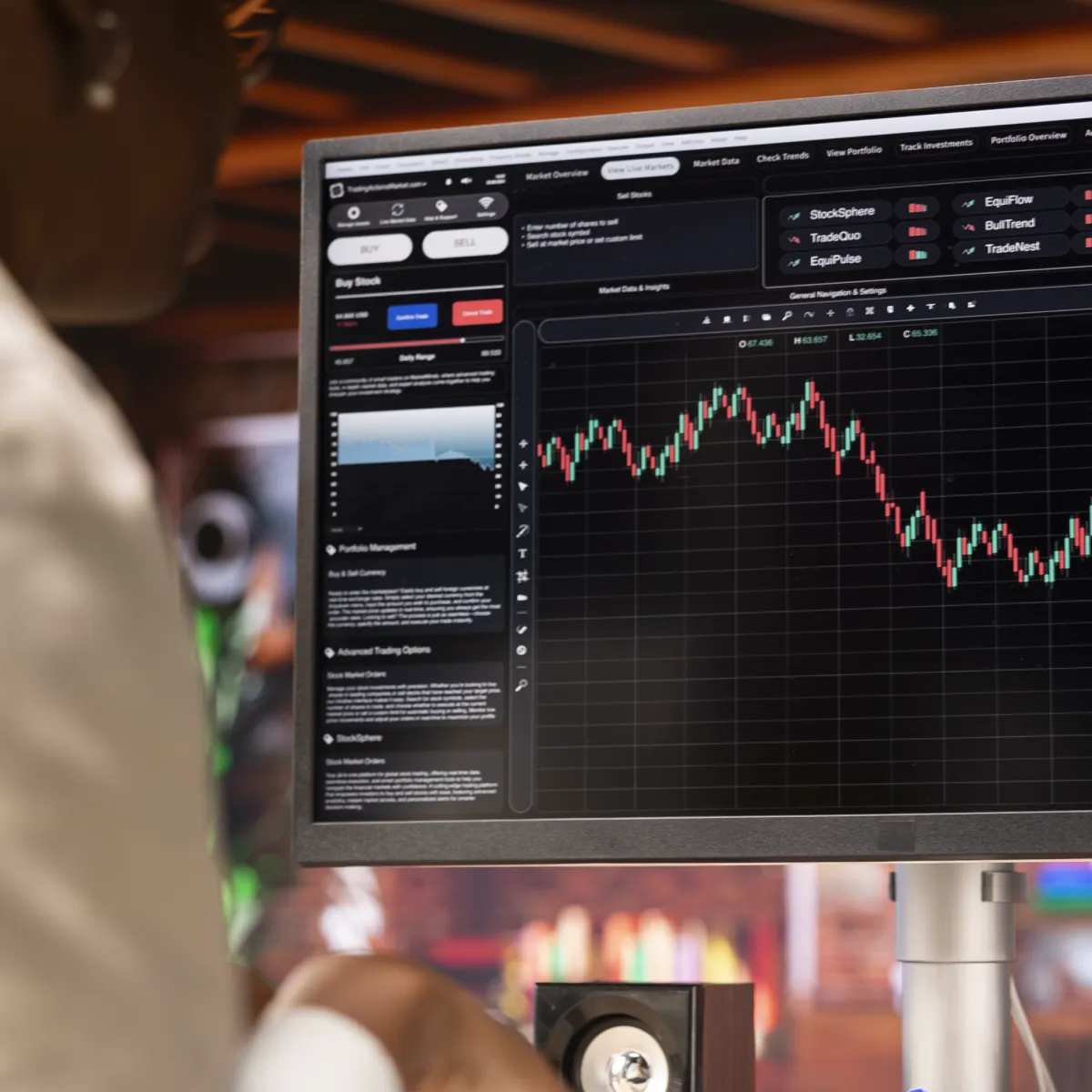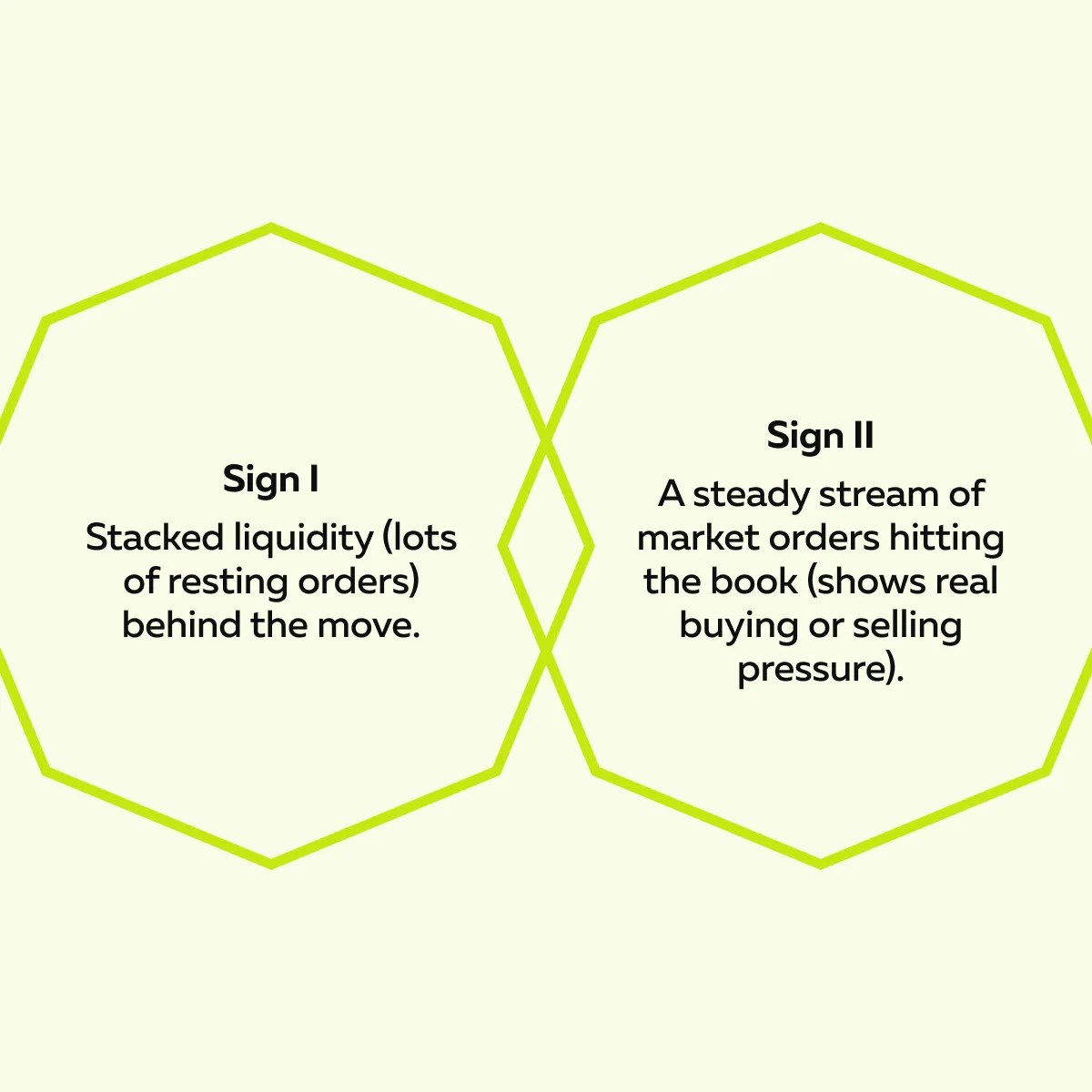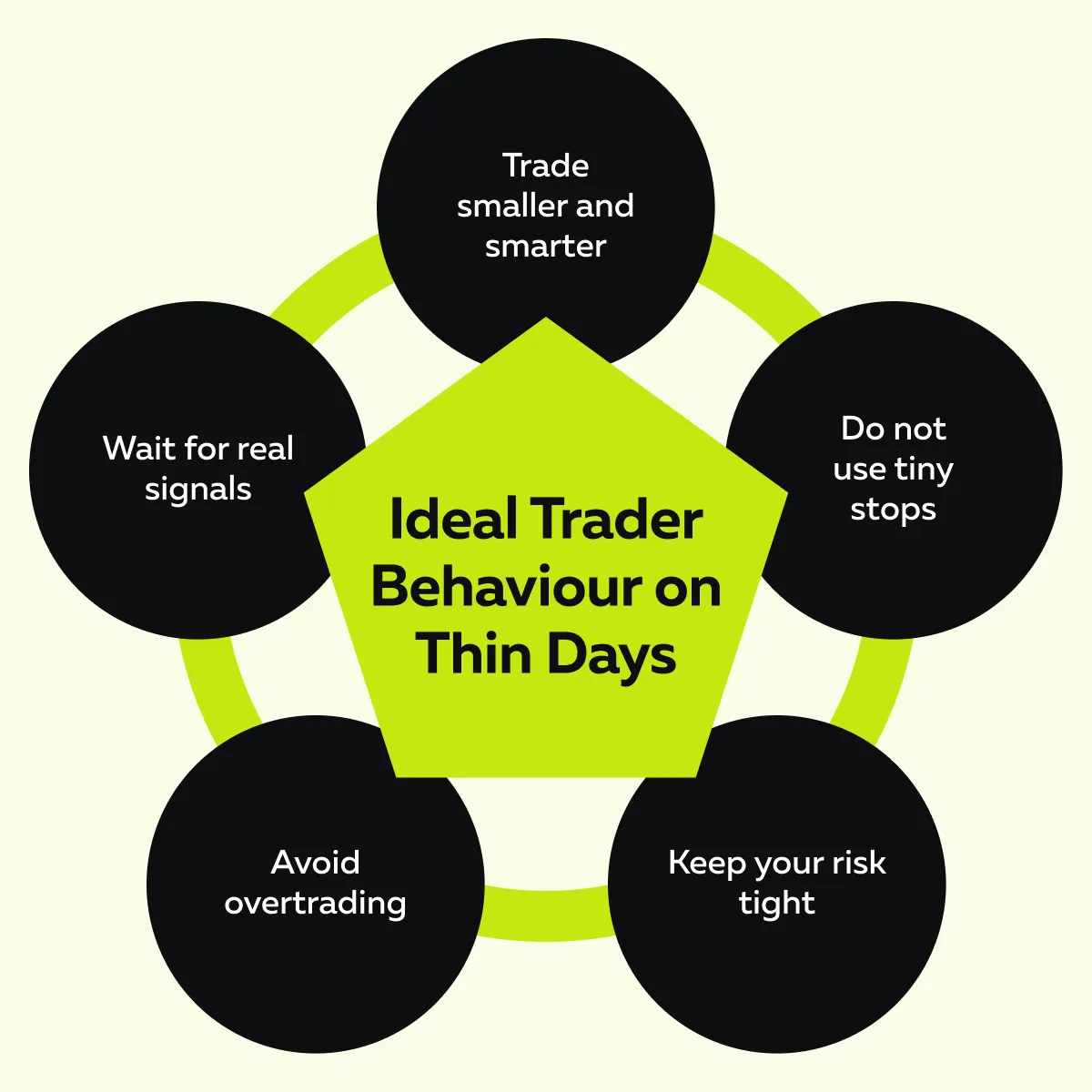Ready to see the market clearly?
Sign up now and make smarter trades today
Education
August 8, 2025
SHARE
Reading the Tape on Low Liquidity Days: Staying Safe When Markets Are Thin

You saw a spike! But got stopped out. There was no volume and no follow-through. How many times have you observed this? Chances are you were trading in a low-liquidity environment and didn’t even know it!
That’s a thin market for you. Here, the loudest signal does not matter! Instead, it’s the quiet gaps between them that cost you the most. So, do you want to avoid the traps most traders fall into on low-volume and high-volatility days?
In this article, you will learn how tape reading in low liquidity can save you from costly mistakes. You’ll also understand how price behaves differently in thin markets, how to spot real versus fake moves using order flow, and when to step back entirely.
What Low Liquidity Means (And Why It’s Risky)
Low liquidity means there aren’t many buy or sell orders sitting in the market. This creates a thin order book. You’ll often see this in specific situations:
- During pre-holiday sessions,
- Summer slowdowns,
- Overnight futures markets, and
- In the middle of the trading day, the activity slows down.
These are times when fewer traders are active, and the market becomes what traders call a “thin market.”
So, Why Is This Risky?

Because in thin markets, even small buy or sell orders can move the price dramatically. There’s very little resistance. One big order can cause a sudden price jump or crash! This fluctuation creates what’s known as an “air pocket.” In this pocket, there is a lack of depth, which causes sudden and unpredictable moves. As a result, there is a higher risk of getting stopped out.
During such times, tape reading in low liquidity becomes highly important. As a trader, you must watch the tape and analyze order flow. This allows you to:
- Spot manipulation
or
- Sense it when big players are moving the price.
How the Price Behaves Differently on Low Liquidity Days
On low liquidity trading days, the market behaves very differently. Since there aren’t many buy or sell orders waiting in the order book, the price fluctuates strongly with far less effort.
Let’s understand better what that means:
-
- Even small market orders, such as someone buying or selling just a few contracts, can push the price several ticks or even points.
- There isn’t much resistance in a thin market.
- As a result, you’ll often see fake breakouts.
- The price might break above a key level, but it fails quickly.
- This happens because there is no strong buying or selling behind it.
- There are just a few orders getting executed from a thin order book.
Bid/Ask Spreads Get Wider!

On a thin day, you have to pay more to get in and out of trades. Your fills are worse, and stop-loss orders can be hit more easily due to sudden price spikes. All this happens because your bid-ask spreads get wider.
Tape reading in low liquidity becomes critical here! You can’t just trust chart patterns. Instead, you must watch how the price reacts to orders in real time.
Let’s see an example:
- Someone places a 10-lot market buy order in the ES futures on a quiet Friday afternoon.
- In a normal market, that might move the price a tick or two.
- But in order flow during thin markets, that same small order could push the price up 3–4 points instantly.
This is why trading during low liquidity requires extra caution. Stay out of trouble on thin days—Bookmap’s real-time order flow tools help you see danger before it happens.
Tape Reading Techniques for Thin Markets
In low-liquidity trading, normal strategies often fail. That’s why most pro traders do tape reading! Want to do it perfectly? Below are some proven techniques you can follow:
Watch for Gaps in Liquidity
In thin markets, the order book has price levels with no buy or sell orders. These are gaps in liquidity. On a tape or on our platform, Bookmap’s heatmap, they show up as “blank zones.” When the price moves into those areas, it can jump quickly! This happens because there’s nothing there to slow it down.
Avoid Trading!
Be cautious! Don’t trade until you see strong and aggressive buying or selling, also called aggressive order flow, pushing through these gaps. If you still prefer to trade, you might end up chasing a move that vanishes.
Effort vs. Reward
Do you know what a classic trap in low liquidity trading looks like? In most cases, you will observe that the price is moving with strength. But, it’s not real! That’s an illusion of momentum created by just a few small orders. Remember, they are enough to push the price and create this illusion!
Therefore, you must try to spot true intent. To do so, watch for these two major signs:

Please note that if there’s no real follow-through, it’s just effort without reward, and likely to reverse.
Beware of Breakouts Without Support
Breakouts in thin markets are often fake! Usually, prices move above or below a key level in thin markets. However, if no new resting bids or offers appear to support that move, it’s usually a trap.
You must realize that a true breakout should always be backed by:
- Liquidity stacking near the breakout level
and
- Continued aggressive order flow, not just one or two prints.
Until you see that, be patient! If you try to chase a breakout without confirmation in tape reading low liquidity conditions, you may get whipsawed. Avoid whipsaws when liquidity dries up—compare Bookmap’s plans and start trading smarter.
Monitor Tape Speed and Size
Normally, thin markets move slowly! There are fewer trades printing on the tape. But when a large player enters:
- The tape speeds up
and
- Bigger trade sizes start hitting the book.
Now, that’s your clue! You must interpret this as someone serious is participating. If you jump in before this shift, you might get faked out. Please realize that order flow in thin markets needs confirmation. Watching the tape’s pace and size is one of the best ways to catch it.
Managing Risk on Thin Days

Low liquidity trading is a different world! Yes, in this environment, the rules change, and so should your risk management. What usually works in a normal market, such as standard stop losses or full position sizes, can backfire in thin markets. It behaves this way because, here, the price moves more erratically due to a lack of resting orders.
So, want to stay safe when trading in low liquidity environments? Below are some important adjustments you must make:
1. Adjust Your Position Size
In a thin order book, the price can move several ticks or even points on a very light volume. If you trade your usual size, you might be risking much more than you think.
Let’s understand better through an example:
-
- Suppose in ES futures, there is normally a 1-point move.
- In low liquidity, this can suddenly turn into a 3–4 point swing.
- This happens even without any major news or volume.
- Usually, that kind of volatility:
- Quickly wipe out gains
or
- Hit your stop before the trade has a chance.
How to Deal with It?
Cut your position size by half or more on thin days, especially when you don’t have a clear and confirmed setup. Please note that this confirmation should come from reading the order flow in thin markets, such as:
- Spotting stacked bids/offers
or
- Identifying sustained aggressive market orders.
2. Use Wider Stops, But Only with Confirmation!
Tight stops can be dangerous in low liquidity conditions. Small random price flicks can easily stop you out, even if your trade idea is right!
For example:
- If you usually risk four ticks per trade.
- On thin days, you need to give it eight ticks or more.
- By doing so, you allow room for the natural noise.
But don’t widen your stop just because the market is thin! Use wider stops only when you’ve seen real commitment, like:
- Liquidity stacking behind the move
or
- Strong aggressive order flow on the tape.
Otherwise, a wider stop just means you’ll take a bigger loss on a bad trade!
3. Avoid Overtrading
On thin days, less is more! You must focus on high-quality setups, as confirmed by the tape reading in low-liquidity conditions. Check out the graphic below to learn what you must do on thin days:

Please realize that when markets are thin, prices can appear busy! It ticks up and down and creates the “illusion of opportunity.” However, in reality, most of this is just noise! That’s the trap of low liquidity trading:
- Small orders cause exaggerated price moves
and
- It tempts traders to jump at every flicker on the tape.
But you, as a trader, must wait for signs of sustained intent before taking action. But what are these signs? These are:
- A rebuild of liquidity (resting bids/ offers reappearing),
- Strong and steady aggressive order flow, and
- Volume clusters showing real participation.
Without these, you’re just reacting to randomness, not real market activity!
4. Focus on Prime Time Only
In thin markets, not every moment in the session is worth trading. Most of the real action happens during very specific windows. Some of the best times to trade in low liquidity conditions are:
- The first 30 minutes after the market opens
and
- Just after a major scheduled event, like CPI releases, FOMC minutes, etc..
These are moments when enough traders step in to create a real order flow you can read and trust.
A Pro Tip
Mark on your charts when volume and liquidity pick up. These “prime windows” are where your edge lives. The rest of the day? It’s often better for watching and learning.
5. Recognize When to Stand Aside
Sometimes, the best trade is no trade at all. Let’s see when you should just sit and watch:

Some common danger zones you should avoid are:
| Zone I: Pre-holiday afternoons | Zone II: Post-news chop | Zone III: Midday lulls |
|
|
|
Let’s understand better when not to trade through an example:
-
- Say you see ES futures moving wildly after a news event.
- But there’s no follow-through!
- It means there is no:
- Liquidity stacking
or
- Continued order flow in thin markets.
- Now, that’s a time to stay flat!
Always remember that capital preservation is part of trading. Don’t burn your edge trying to force trades in a market that’s not giving anything back!
Conclusion
Low liquidity trading is all about higher risk! When the order book is thin, the price can move sharply on a tiny volume. This leads to the creation of traps and fake breakouts. That’s why blindly following price action doesn’t work these days!
Instead, to gain an edge, you must do tape reading in low liquidity conditions. You should also watch for real order flow in thin markets, such as aggressive volume, liquidity stacking, and sudden speed shifts.
By watching for these clues, you can tell whether a move is genuine or just noise! To make smart judgments as a trader, you should start using our avant-garde real-time market analysis tool, Bookmap. It comes loaded with several features, like heatmap, volume dots, and liquidity indicators.
By using these features, you can clearly see where the real buyers and sellers are hiding. So, want to avoid getting chopped up by false moves? See what’s really behind price moves on low-liquidity days—Bookmap’s heatmap and volume dots reveal the flow.
FAQ
1. What’s the difference between low liquidity and low volume?
Both these terms are different:
| Low liquidity | Low volume |
| Low liquidity means there aren’t many buy or sell orders sitting in the market at each price level. | Low volume means not many trades are actually happening. |
A market can have high volume (lots of trades) but still be low in liquidity. This happens particularly if those trades move prices through thin areas!
In low liquidity trading, even small orders can cause major price fluctuations. That’s because the order book is too empty to absorb them smoothly.
2. Why are thin markets risky?
Thin markets are risky because the price fluctuates a lot in them, with very little buying or selling. Even small orders can push the price several points if there are gaps in the order book! This makes it easy for traders to:
- Get tricked by sudden moves
or
- Get stopped out quickly.
What is the negative effect of thin markets? Most of the time, you may think a breakout is real. However, in low liquidity, it could just be price slipping through air pockets with no real strength behind it.
3. How can tape reading help in thin markets?
Tape reading in low liquidity markets allows you to see if price moves are real or fake. Instead of just looking at charts, tape reading lets you watch the “flow of trades” in real time. You can see:
- If buyers or sellers are actually stepping in
or
- If the price is just moving because the order book is thin.
Through tape reading, you can avoid chasing false moves. Also, you can improve your timing when trading thin markets.
4. Does Bookmap help on thin days?
Yes, Bookmap is a great real-time market analysis tool. You can use it for low-liquidity trading. It shows the order book visually using:
- Heatmap
and
- Volume dots.
Such a visualization allows you to see where liquidity is missing (air pockets) and where real buy or sell interest is building up. Please note that on thin days, normal price charts are highly misleading.
Therefore, you must use our tool Bookmap, which lets you spot real order flow in thin markets. Make better and safer trading decisions with Bookmap!